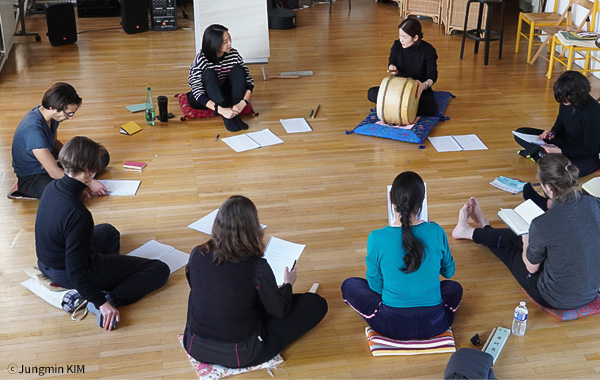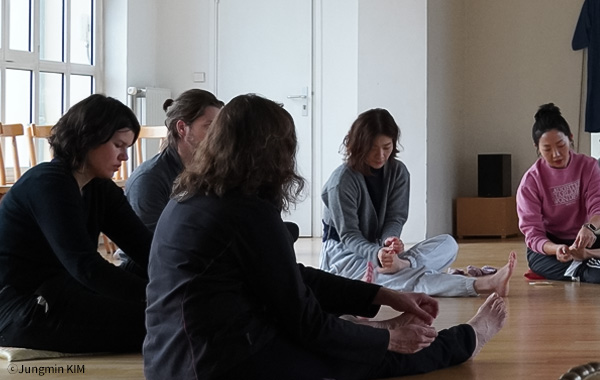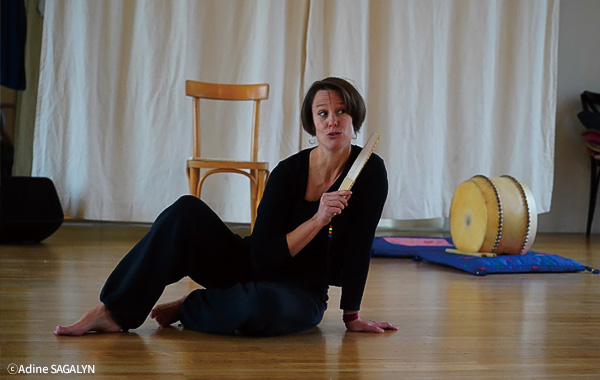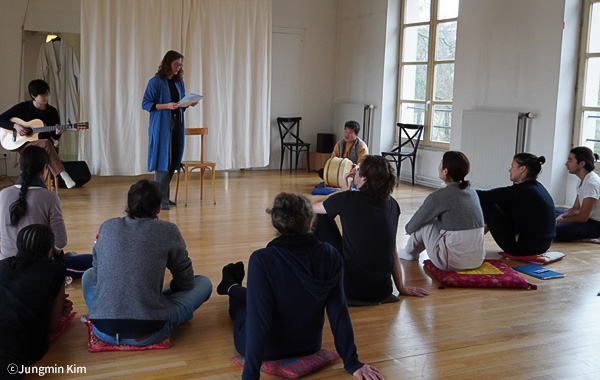내일의 전통, 오늘의 관객을 만나다
월간국립극장
-
내일의 전통 SPOTLIGHT 더보기
-
무대, 탐미 STAGES 더보기
- 미리보기, 하나 - 국립극장 기획공연 <2023 함께, 봄> ‘함께’를 더하는 합주
- 미리보기, 둘 - 국립무용단 <넥스트 스텝Ⅲ: 안무가 프로젝트> 경험에서 길어 올린 춤
- 미리보기, 셋 - 국립국악관현악단 <엔통이의 동요나라2> 어린이 음악회의 귀환
- 미리보기, 넷 ① - 국립창극단 <절창Ⅰ·Ⅱ> 완창을 넘어 절창의 시대로
- 미리보기, 넷 ② - 국립창극단 <절창Ⅲ> ‘소리의 이상향’을 꿈꾸다
- 미리보기, 다섯 - 주운숙의 동초제 ‘흥보가’ 낭중지추의 소리꾼
- 미리보기, 여섯 - 국립국악관현악단 <정오의 음악회> 봄날의 음악 여행 좋아하세요?
-
안목의 성장 INSIGHT 더보기
-
극장 속으로 INTO THEATER 더보기
하물며 판소리에 대한 문화 DNA가 없는 이방인의 몸에서 뻗어나간 소리가
어떤 모습으로 피어날지는 예측조차 어렵다. 그렇기에 몸과 소리를 만나게 하는 자리가 필요했다.
이방인의 소리
지난겨울, 소리꾼 이자람은 고수 이준형과 기타리스트 김정민, 통역·기록작가(이자 이 글을 쓰고 있는) 박다솔을 이끌고 프랑스 파리에서 약 2주간 ‘판소리 마스터 클래스: 소리꾼 되기’를 진행했다. 이는 배우를 위한 연수 기관인 배우전통연구협회ARTA, Association de Recherche des Traditions de l'Acteur의 초청으로 이뤄진 것으로, 참여 예술가들이 이자람의 창작 판소리 작품인 <이방인의 노래> 일부를 배우고, 이를 통해 판소리 소리꾼의 연행 방식을 습득하는 데에 목표를 두었다.
마스터 클래스에는 태양극단의 배우 유디트Judith와 조명감독 비르지니Virginie, 아마추어 배우 미진Meejin과 제롬Jérôme, 배우이자 싱어송라이터 엘리즈Elise와 디미트리Dimitri, 그리고 아마추어 배우이자 댄서 노에Noé까지 총 일곱 명의 예술가가 참여했다. 모두 프랑스어를 사용하기는 했으나 출신지나 나이, 직업, 전문 분야, 지원 동기는 각양각색이었다.
 이자람의 판소리 마스터 클래스 진행 장면
이자람의 판소리 마스터 클래스 진행 장면
유디트는 2015년에 ARTA에서 이미 한차례 이자람의 판소리 워크숍에 참여한 바 있고, 비르지니는 그 당시 발표를 보러 와 이자람의 소리를 들으며 매우 강렬한 인상을 받았다고 한다. 평소 판소리에 관심을 두고 있던 미진은 한국을 방문해 민혜성 교수로부터 판소리를 배운 적이 있고, 현재 창작 판소리 극작을 시도하고 있다. 더불어 소리꾼 이자람에 대한 궁금증을 가지고 수업에 참여하게 되었다. 제롬 또한 이자람의 공연을 본 적이 있다. 제롬은 2017년 아비뇽에서 이자람의 <이방인의 노래>를 관람하며 판소리에 흥미를 갖게 되었는데, 이번의 마스터 클래스 공고를 보고 곧바로 참가 신청을 했다고 밝혔다. 반면 디미트리와 엘리즈는 자신들은 판소리에 대해 아는 바가 거의 없다고 고백했다. 디미트리의 경우 ARTA에서 진행된 우싱궈의 마스터 클래스에 참여하며 세상을 더욱 넓게 바라보게 됨을 깨닫고 연이어 판소리 마스터 클래스까지 신청했다. 엘리즈는 태양극단의 배우이자 ARTA의 공동 예술감독인 모리스Maurice의 추천으로 수업에 오게 되었다고 했다. 마지막으로, 파리의 한 사물놀이 동호회에서 활동 중이기도 한 노에 또한 판소리를 공부한 프랑스인 친구에게 추천을 받았다고 마스터 클래스 참여 동기를 설명했다.
하지만 판소리를 얼마나 많이 잘 알고 있느냐는 중요하지 않았다. 무엇보다 중요한 것은 낯선 문화에 대한 존중과 열린 태도였기 때문이다. 그리고 이는 참여 예술가들이 마스터 클래스에서 함께 보내는 시간이 쌓여감에 따라 자연스레 형성됐다.
소리꾼의 몸과 언어를 직조하며
마스터 클래스 첫날 아침, 참여자들은 동그랗게 원을 그리고 앉아 양말을 벗고 발 마사지를 하기 시작했다. 이자람은 소리꾼에게 두 발로 견고하게 땅을 딛고 서는 일이 얼마나 중요한지 설명하며 자신의 발 마사지 루틴을 보여주고, 이를 따라 할 수 있게끔 했다. 이런 방식으로 마스터 클래스 첫 나흘 동안 참가자들은 매일 하나씩 새로운 몸풀기 동작을 배워나갔고, 모든 동작을 배운 이후부터는 규칙적인 동작으로 매일 아침을 함께 시작했다. 바닥에 방석을 깔고 앉아 자신의 맨발을 어루만지고 상대의 발에 안부를 묻고 나면, 마음의 벽이 이를 데 없이 허물어져 낯선 것을 한결 온화하게 받아들일 수 있는 상태가 되곤 했다.
<이방인의 노래> 다섯 곡을 전수받는 방식에도 이와 같이 루틴이 존재했다. 프랑스로 오기 전, 이자람은 <이방인의 노래> 중 각각 진양·중모리·중중모리·엇중모리·자진모리로 구성된 총 다섯 개의 창(곡)과 아니리를 발췌했고, 이를 번역해 한국어와 프랑스어가 나란히 적힌 대본으로 만들어 사전에 준비했다. 처음 닷새 동안은 참가자들이 이야기 순서에 따라 매일 한 곡씩 배워나갔다. 이준형 고수는 북을 치며 장단을 익힐 수 있도록 했고, 이자람은 각 장단을 몸으로 받아들일 수 있도록 간단한 무용 동작을 만들어 알려주었다. 박다솔은 이들이 한글로 불러야 하는 각 단어와 문장이 불어로 무엇을 의미하는지 설명하는 역할을 담당했다. 이 과정을 거친 후, 참가자들은 이자람의 지도하에 본격적으로 소리를 배웠다.
 발 마사지 하고 있는 참가자들
발 마사지 하고 있는 참가자들
참가자들이 가장 어려워한 것은 모든 곡을 한국어로 불러야 한다는 점이었다. 소리꾼이 얼마나 구체적으로 감각하는지에 따라 관객으로 하여금 구체적 상상력을 불러일으키기 때문에, 참가자들은 한국어 발음을 단순히 모방하는 것 이상으로 단어와 문장을 이해해야 했다. 비르지니는 “단어의 의미에 따라 소리를 하나하나 세분화해 이해하고 모방하는 방식이 무척 효과적이었다.”라고 말하며, 태양극단의 배우들 또한 새로운 언어를 음성학적으로 접근해 습득하는 경우가 자주 있다고 설명하기도 했다. 제롬은 “판소리에서 한글이라는 언어 자체가 소리 재료로 사용된다는 점을 인식하고, 내가 어떤 말을 하고 있는지 이해하려 했다.”라고 말했는데, 이는 소리꾼이 각각의 단어와 문장에 싣는 심상의 중요성에 대해 인지했다는 뜻이기도 하다. 소리꾼의 상상이 곧 관객에게 가닿는 모든 것이라는 점에서, 언어의 구체성을 획득하는 일은 필수적일 수밖에 없었다.
이자람의 마스터 클래스를 관통하는 하나의 단어를 꼽는다면, 그것은 바로 ‘상상력’일 것이다. 그는 소리꾼의 상상이 구체적일수록, 관객의 상상력을 무한히 확장해 낼 수 있다고 설명하며 소리꾼의 몸과 언어, 노래를 통해 발현되는 모든 것에는 상상력이 동반되어야 함을 강조했다. 미진은 마스터 클래스에서 가장 기억에 남는 이야기가 무엇이었냐는 질문에 “상상력이 있다면 무엇이든 가능하다는 말이 가장 마음에 와닿았다.”라고 답하기도 했다. 참가자들은 한 손에 부채를 쥔 소리꾼이 무대 위에 홀로 서서 소리꾼의 상상력만으로 관객들의 공간을 이동시키고 지각을 차리게 할 수 있다는 사실이 무척 매력적이라고 입을 모아 얘기했다.
 <이방인의 노래> 한 대목을 연행 중인 비르지니
<이방인의 노래> 한 대목을 연행 중인 비르지니
참가자들이 소리꾼 연행에서 가장 흥미를 느끼는 동시에 어려움을 겪은 것 중 하나는 무대 위 소리꾼이 어떤 자아나 캐릭터를 가져야 하느냐는 것이었다. 이에 대한 참가자의 질문에 이자람은 “나에게도 나만의 소리꾼 자아가 있다. 그는 이자람이라는 사람의 좋은 점이 투영된 존재이고, 이야기를 들려주고 싶어 하는 자다. 이것이 내가 창작 판소리 작품을 선택할 때 ‘어떤 이야기가 나의 마음을 건드리는가?’에 집중하는 이유다.”라고 대답했다. 참가자들은 특히 소리꾼의 ‘이야기하고자 하는 욕망’이 곧 소리꾼의 호기심을 자극하고 이야기 속 인물을 들여다보게 만든다는 점을 흥미로워했다. 디미트리는 자신이 가수로서 무대 위에 서서 관객에게 말을 걸 때면 종종 낯선 감정을 느끼곤 했다는 사실을 고백하면서, ‘소리꾼 자아’가 향후 자신의 무대에 긍정적으로 적용될 수 있을 거라는 기대를 드러내기도 했다.
전통으로, 그러나 새로움으로
마스터 클래스가 진행되는 도중 재미있는 일도 벌어졌다. ARTA는 기관의 설립 배경부터 지리적인 위치까지 태양극단과 깊은 관계를 맺고 있고, 현재 ARTA의 공동 예술감독인 모리스와 조르주George, 두치오Duccio 또한 태양극단 소속 배우들이다. 클래스가 진행되는 동안 공동 예술감독들이 종종 클래스를 참관하러 왔는데, “이자람이 보여주고 또한 설명하는 판소리는 프랑스에는 존재하지 않는 것”이라고 설명하며 놀라움을 감추지 않았다. 특히 모리스는 “아리안이 꼭 이것을 봐야 한다.”라며 태양극단의 연출가 아리안 므누슈킨Ariane Mnouchkine을 모셔 오기도 했다. 이자람의 판소리 연행을 본 아리안은 “한국의 전통음악이나 판소리에 대해서는 잘 알고 있다. 하지만 이자람이 보여준 부채의 사용이나 역동성, 소설의 판소리화 같은 현대 창작 판소리는 무척 새롭고 인상적이다.”라고 말하며 깊은 관심을 드러내기도 했다.
 <이방인의 노래> 한 대목을 연행 중인 유디트와 이를 관람하는 참가자들
<이방인의 노래> 한 대목을 연행 중인 유디트와 이를 관람하는 참가자들
마스터 클래스 참가자들 또한 전통과 현대가 공존하는 판소리 형식을 직접 경험하며 판소리를 새롭게 받아들이게 되었다고 말했다. 미진은 “이 마스터 클래스 덕분에 판소리가 전통성을 보존하면서 어떻게 더 현대적으로 변화할 수 있는지 이해하게 되었다. 소리꾼이 될 수 있다는 자신감을 얻기도 했다.”라고 얘기했고, 비르지니는 “프랑스에는 노래하는 이야기꾼이라는 형식이 존재하지 않기 때문에, 판소리는 내게 완전히 새로운 예술 장르로 다가왔다. 이 형식에 영감을 받아 새로운 작품을 만들어보고 싶다.”라고 소감을 밝혔다. 판소리를 마스터하고 소리꾼이 되기에 2주라는 시간은 무척 짧았다. 그러나 이 시간을 보낸 이들이 향후 어떤 방식으로 판소리를 계속해 나갈지, 판소리가 이들을 통해 어떤 방식으로 변화해 나갈지 기대하게 된다.
문화는 변화하고 진화한다. 일곱 명의 참가자에게는 이제 저마다의 소리꾼 자아가 (크든, 작든, 뚜렷하게든, 희미하게든) 존재할 것이다. 이들의 몸을 통해 판소리라는 장르가 어떻게 다시 변화하고 진화할지 사뭇 궁금하다.
Therefore it is much more difficult to predict what the pansori that spreads out from the body of foreigners who do not have the cultuaral DNA of pansori would be.
So a place for body and pansori to meet was needed.
Pansori by foreigners
Last winter, a singer and performer of pansori Jaram Lee conducted ‘Pansori Master Class: Becoming a Performer’ for two weeks in Paris with a gosu (a drummer in performances of pansori) Jun–hyung Lee, guitarist Jung–min Kim, and interpreter and record writer Dasol Park (as well as the author of this essay). The master class was carried out with the invitation from ARTA(Association de Recherche des Traditions de l'Acteur), with the goal of learning the performance methods of pansori singers by studying parts of <Stranger’s song>, which is the creative pansori work of Jaram Lee.
In the master class, a total of seven artists participated in including the actor Judith of the Théâtre du Soleil, and the lighting director Virginie, the amateur actors Meejin and Jérôme, the actors and singer-songwriters Elise and Dimitri and the amateur actor and dancer Noé. All of them speak French, but they were all different in many ways, such as their home, age, occupation, and specialty, and motivation for participation in the master classes.
 Scene from Jaram Lee’s pansori master class
Scene from Jaram Lee’s pansori master class
In 2015, Judith already had completed a pansori workshop at the same institution, and at that time, Virginie attended the presentation and was amazed by the sound and performance of Jaram Lee. Mijin, who has been always interested in pansori, visited Korea and learned pansori from the professor Hye-Sung Min, and she is currently attempting to produce her own creative pansori. She participated in the master class out of curiosity about the performer Jaram Lee.
Jérôme also watched Jaram Lee's performance before. He became interested in pansori after watching her <Stranger’s Song> in Avignon in 2017, so he immediately applied for participation after finding the announcement of the master class. On the other hand, Dimitri and Elise confessed that they had very little knowledge of pansori. In case of Dimitri, he realized that he could see the world more broadly after joining the master class of Wu Hsing-kuo conducted by ARTA, so applied for a pansori master class right after. Elise said she came to class with the recommendation of Maurice, the actress of the Théâtre du Soleil as well as the co -art director of ARTA. Lastly, Noé, who is also active at a Samullori club in Paris, also explained that the motivation for participating in the master class was a recommendation from a French friend who studied pansori.
However, how much they knew about pansori did not matter. The most crucial thing was whether they had respect and open attitudes toward culture. Participating artists could naturally form those properties as they spent time in the master class.
Weave the body and language of the performer
On the first morning of the master class, the participants sat in a circle, took off their socks and began to massage their feet. Jaram Lee explained the importance of working on the ground firmly with two feet while showing her foot massage routine and let them follow it. In this way, for the first four days of the master class, the participants learned new warm-up exercises everyday, and after learning all the movements, they opened every morning with a regular exercise routine. The participants touched their bare feet and asked others how their feet are, sitting on the floor with a cushion, and then they could calm down and be in a state where they could accept strangers more mildly.
There was also a routine in the way of learning five songs of the <Stranger’s Song>. Before coming to France, Jaram Lee extracted five songs and aniri(descriptive speech), which consisted of jinyang, jungmori, jungjungmori, eotjungmori, and jajinori respectively, and prepared scripts written in both Korean and French in advance. For the first five days, the participants learned one song every day according to the order of the story. The gosu Joon-hyung Lee played drums to teach the rhythm, and Jaram Lee instructed a simple dance movement to accept each rhythm with their bodies. Dasol Park’s role was to explain what each word and sentence they had to sing in Korean means in French. By going through this process, the participants learned pansori in earnest under the guidance of Jaram Lee.
 Participants massaging their feet
Participants massaging their feet
The most challenging part for the participants was to sing all songs in Korean. Participants had to fully understand words and sentences beyond simply imitating Korean pronunciations, because the audience can have detailed imagination depending on how specific the performer senses the song. "It was very effective to understand and imitate the sounds by breaking them according to the meaning of the word," Virginie said, and added that actors of the Théâtre du Soleil also often acquire new languages in a phonetic approach.
Jérôme said, “I recognized that the language Hangul itself was used as a sound material in Pansori, and tried to understand what I was talking about.” This also means that he was aware of the importance of imagery which a performer conveys in each word and sentence. It was essential to acquire the specificity of the language, in that the imagination of the performer is all that touches the audience.
If you choose a single word that penetrates Jaram Lee's master class, it will be 'imagination'. She explained that the more specific the imagination of the performer is, the broader the imagination of the audience can expand, even indefinitely, emphasizing that the imagination should be accompanied with everything expressed through the body, language, and song of the performer. Mijin replied to the question of what was the most memorable story in the master class, "It was the saying that nothing is impossible if we have imagination." Participants unanimously praised that it is very fascinating to see the performer standing on the stage alone with a fan in one hand can move the audience's space and perception just by his/her imagination.
 Virginie performing a passage from <Stranger's Song>
Virginie performing a passage from <Stranger's Song>
One of the most interesting but struggling thing for the participants during the pansori performance was to consider what kind of self or character the performer should have on the stage. In response to the participant's question about this, Jaram Lee said, “I have my own persona as a pansori singer and performer. The self is an identity that projects the goodness of Jaram Lee, and it wants to tell stories. This is why I focus on ‘what kind of story touches my heart?’ when I choose an creative pansori work?” Participants were especially interested in that the performer's ‘desire to talk’ stimulates the curiosity of the performer and makes him/her look into the characters in the story. Dimitri confessed that he often felt unfamiliar feelings when he stood on the stage as a singer and talked to the audience, and expressed his expectation that the ’himself as a pansori performer’ could be applied to his stage positively.
To tradition, but new
During the master class, we had a fun experience. ARTA has a close relationship with the Théâtre du Soleil not only for the foundation background of the institution but also for the geographic location. Moreover, co-art directors of ARTA, Maurice, George, and Duccio, are also the actors of the Théâtre du Soleil. During the class, the co-art directors were often present, and they expressed their wonder without concealing by saying that “Jaram Lee shows and explains pansori which does not exist in France.” In particular, Maurice even invited the Théâtre du Soleil’s director Ariane Mnouchkine, saying "Ariane must see this." After watching Jaram Lee’s Pansori performance, Ariane showed great interest by saying, “I am already familiar with Korean traditional music and pansori. However, the modern creative pansori showed by Jaram Lee is very contemporary and impressive in many ways such as the use of a fan, dynamics, and pansori based on the novel.”
 Judith performing a passage of <Stranger’s song> and participants watching it
Judith performing a passage of <Stranger’s song> and participants watching it
Participants of the master class also commented that they could accept pansori in a new manner by experiencing the pansori format where tradition and modernity coexist in person. Mijin said that “this master class has made me understand how pansori can become more modern as it preserves tradition. Also I could gain confidence that I can be a performer.” Virginie delivered his impressions by saying “Since there is no concept of a singing storyteller in France, pansori has come to me as a completely fresh art genre for me. I want to create a new work inspired by this format.” A two-week period of time was too short to master pansori and become a performer. However, I am still looking forward to observing how those who spend this time would continue pansori in the future, and how pansori would develop through them.
Culture changes and evolves. Seven participants now must have their own identities as a performer (whether it is big, small, clear, or faint). I wonder how the genre of pansori will transform and progress again through their bodies.
Translator. Moony Choi
월간지 '월간 국립극장' 뉴스레터 구독 신청
뉴스레터 구독은 홈페이지 회원 가입 시 신청 가능하며, 다양한 국립극장 소식을 함께 받아보실 수 있습니다.
또는 카카오톡 채널을 통해 편리하게 '월간 국립극장' 뉴스레터를 받아보세요.
※회원가입 시 이메일 수신 동의 필요 (기존회원인 경우 회원정보수정 > 고객서비스 > 메일링 수신 동의 선택)






